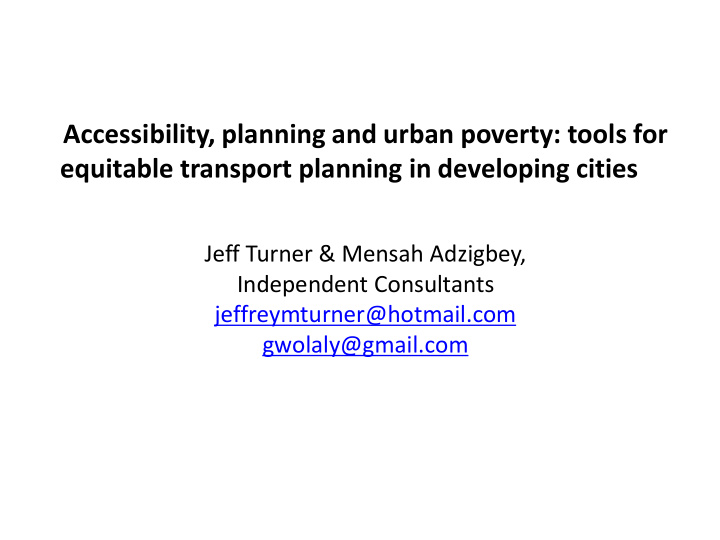



Accessibility, planning and urban poverty: tools for equitable transport planning in developing cities Jeff Turner & Mensah Adzigbey, Independent Consultants jeffreymturner@hotmail.com gwolaly@gmail.com
Overview • What do we mean by accessibility? • Directions in new technologies for changing transport planning practice • Possible approach to understand transport needs of urban poor • Experience of approach in Kigali
What is accessibility? • It means different things to different people • In UK and in the discussion about Rural Development in developing countries it often means people being able to access the transport network, but through it being able to access to services, markets and opportunities. • In Continental Europe it is tightly focused one on physical access to the transport network and a concentration on access for disabled and mobility impaired people and the heights of kerbs and steps into buses and trains etc. • This is also reflected globally in such things as the Brazilian Urban Accessibility Programme.
What is accessibility? • World Bank report ‘Cities on the Move’ highlights the necessary characteristics of urban transport for low-income communities as: – affordable, – accessible, – available, – acceptable.
New developments • New technologies can help in changing transport planning practices • They can help by providing a low-cost option to increased monitoring • They can change the governance around a project
New developments • It will draw on Web, SmartPhone and SMS- based technology based mapping and reporting tools such as: • ‘FixmyStreet’ www.fixmystreet.com web- based reporting sites for urban management • Harrassmap’ www.harrassmap.org • Transparent Chennai www.transparentchennai.com for mapping and oversight of urban facilities and services
New Developments
Monitoring harassment in urban transport • Sexual harassment on urban public transport is frequently reported in transport research. • Often a taboo subject amongst professionals • Women may not have the social space to complain. • Technologies enable participatory monitoring of this experience.
Spatial Mapping of Services • An NGO in Chennai is supporting community involvement in planning decisions. • A land-use and density map has been made through volunteers posted on the web • A walking audit is being undertaken to document the condition of sidewalks including toilets.
Monitoring walking paths • Researchers are using GPS and GIS to map walking Most used routes patterns and experiences • Highlights are of focus points for planning solutions Source: Hodgson (2011)
Rapid Assessment Methodology • Step 1 - Use GPS and mobile technology to map and measure public transport routes in the city • Step 2 - Measure the frequency of public transport and the waiting times • Step 3 – To gather qualitative information on how acceptable different means of transport • Step 4 -To calculate how affordable public transport is in the city using the affordability index method. • Step 5 – Qualitative Discussions with householders and communities about how easy it is to access different parts of the city • Step 6 - To gather information from communities on how acceptable different means of transport. • Step 7 - To understand qualitatively from communities how affordable public transport is in the city.
PUBLIC TRANSPORT IN KIGALI Public transport in Kigali mainly consists of buses, from 18 seats to 36 seats, and motorbike taxis.
PUBLIC TRANSPORT IN KIGALI (Accessibility) While city dwellers are well connected to the services within the city centre, residents on the outskirts of the city are not. The settlements on the edge of the city are not served by buses, only motorbikes operate in those communities. Consequently, unaffordable motorbike fares, inadequate road conditions, and lack of street lights limit their abilities to access local services at nights and when it rains
PUBLIC TRANSPORT IN KIGALI (Availability) • Public transport services start from early in the morning till 9:00 at night, and the major routes are well served. • The outskirts of the city are not, however, well served. People are in desperate needs of public transport reaching and serving their settlements. GPS tracking of bus routes to three low income settlements on the edge of the city showed that communities can be as far as 1.83 km away from the nearest bus stop ( Map-slide 2, routes FG, KL and HI).
PUBLIC TRANSPORT IN KIGALI (Availability) Motorbike taxis are available from bus stops to the settlements at the same price as the city fares but it becomes difficult when residents have luggage and goods to carry By law it is not allowed to carry loads on motorbike taxis so at the entrance of every settlement there exist load carrying corporations charging about 30-50 RWF per Kg of goods carried. A business man in Niboye sector said he spends about 50 RWF per day on wheelbarrow services from the bus stop to his shop (map-route FG).
PUBLIC TRANSPORT IN KIGALI (Affordability) Set between 200 and 300 RWF by the Rwanda Utility • Regulatory Authority (RURA), public transport fares are widely accepted among users. For most of the routes within Kigali the bus fares are set • at 200 Francs, which is widely accepted by the users. Motorbike taxis are more expensive and depend on length • of journey but usually cost between 300 and 500 RWF. The cost also varies at night. For a trip normally charged at 800 Francs this increases to 1000 RWF because it was dark. Weather conditions do not appear to have a major impact on • fares.
Nampula, Mozambique
Conclusions • We need to better understand the accessibility of low-income urban communities to services and opportunities? • There are new directions in new technologies that can change transport planning practice • The approach presented helps understand transport needs of urban poor • It has been piloted in Kigali and Nampula and hopefully furher collaborations can be developed.
THANK YOU
Recommend
More recommend